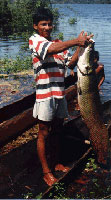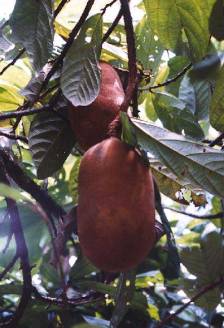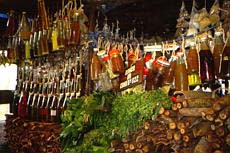Advertising by Google
Amazon flavours - cuisine and fruits
By Robério Braga, ex-Secretary of Culture of State of Amazonas.
Source of images: Embrapa.
Read also:
Travel to the Amazon
Brazilian Cuisine
The flavor of Amazon is that of the many distinct
and unique brazils, strewn over the continent
of Brazil, which seduces and enchants, and is in
the fruits, the liqueurs, the simplest of dishes
and the forest treats served without the
pretense of grand feasts.
The dishes created by the
hands of the cabocas, simply,
without touch ups or airs of
mystery, are always very peculiar.
Some of them involve hundreds
of years of knowledge and
practice, which the younger
generations are relinquishing, but
even so they are refined in their
preparation and simple in their
presentation.
The seduction of pachicá, a
type of sarapatel made of turtle
viscera, tender internal parts,
fatty morsels and blood coagulated
in vinegar, has the flavor of
reminiscence, since it is no longer
served at just any table. Chopped into tiny pieces, seasoned
with chicory, murupi chili, salt and
lemon, it is all served in the turtle
shell, used as a casserole, and
cooked over a low flame. Later
on, the suruí flour, or water flour
as it is called by the locals, is
added. While it cooks, the aroma
is a most revealing evidence,
impossible to ignore.
But if you are truly imbued
with a holy yearning to taste the
dishes that spring from a beautiful
turtle, try the mince, stew or
sarapatel, which are indeed very
special, aptly served at magnificent
parties, unlike in the past,
in the days of the empire, when
it was the dish of simple people,
sold in street markets.
Many of the dishes are
served with piracuí, or fish flour,
considered by some specialists
as a complete food. Almost always
made of acari, which is
gutted, salted and dried in the
sun, later shredded and put in the
oven to complete the dehydration
process, it stands on its own,
but also accompanies other
dishes at the table.
In addition to the main dishes,
fish is used in delicious
canapés such as fish baked over
grates lined with banana leaves.
And those who are not satisfied
can try the Amazon caviar made of pirarucu ova,
for example, placed in an earthenware bowl to
marinate in wine, or preferably sugar cane vinegar.
It becomes a paste and is placed on a sieve to
drain, from which it follows to the smoking room.
The fire that will slowly smoke it must be made of
wood, preferably hardwood, without acid, curing it
to the point desired by the cook or customer. The
paste can be put in cans into a bain-marie, after
which it will be ready to take in the journey to the
party. There are, nonetheless, more urban flavors,
which have incorporated other tastes and
seasonings, casually ordered by watering mouths.
It is the case of the tambaqui, which can be served
in fried or cooked stakes, with a tasty broth,
seasoned with parsley, chive, onion, garlic, tomato
and coloring. But, if not thus, it can be tambaqui
baked in coal, called moquém by the natives, also
in high demand.

Pirarucu
There are also appetizing dishes made with
pirarucu, a fish that can be very rich and therefore
forbidden to women who have recently given birth,
to those with open wounds, eye pains, stings, itches,
eczemas and impetigo, but whose filet, depending
on the season, can be found in any restaurant of
the towns in the region. Pirarucu can be dried and
fried, it can be made into pancakes, dried and
stewed, and can even elegantly come to the table
in tailcoat, when it becomes the highlight of
important celebrations, mixed with cassava flour in
a very special dish. It is a versatile fish. Pirarucu,
dried or fresh, is fit for high dignitaries, and together
with minced tambaqui, it is always welcome in the
most elegant feasts, even at business luncheons,
permeating endless talk of business and deals that
are not always closed. And those who have time to
savor can start with the pirarucu cakes.
In some cases, in order to enjoy the flavor of
the Amazon you need to be patient and knowledgeable
regarding the fish bones, because it is almost
an art to get rid of them without choking. But this
only demands expertise if the gourmet is facing a
jaraqui, matrinxã, branquinha or sardine, which, in
fact, are everyday dishes of the natives, who skillfully
expel, discretely through the corners of the mouth,
the many bones that are found profusely in these
fishes.
And if you are unable to get rid of the bones,
call a caboco who will know a special prayer to
remove the fish bones from the back of your throat,
either by invoking Jesus of Nazareth or calling upon
the powers of Saint Braz, after all the table guests
have twirled their plates, or by turning the coal in
the fire that cooked the fish, or even by serving a
generous portion of cassava flour or banana, which
will surely do the trick.
That's why some prefer to serve the tambaqui
casserole. After the fish is scaled and gutted, it is
cut and cleaned with lemon in order to remove any
rank smell. It is then boiled with slices of tomato,
parsley, shallot, chives, onion and a little Portuguese
olive oil. It is served with cassava flour and chili,
murupi or malagueta, according to taste. Alternatively,
it can be baked in live coal, and that is how
visitors prefer it; baked in oven, stewed or even
marinated, or served as dried tambaqui. Each dish
has the luxurious touch of natural cuisine.
If you to want to try something really special,
you can choose from among hundreds of other
tidbits, such as shredded pirarucu with pupunha rice,
or the tambaqui mojicaf, and also
the special purée, stuffed fish
baked in the oven and cassava
farofa, which, for some, don't
even come close to the fried
jaraqui, the stuffed sardines in
banana leaves or pacu baked in
the oven. And everything goes
with açaí bread, and to top it all
off you can try cream of cupuaçu
or araçá-boi and even some
banana-prata cake.
If the day calls for a dish of
jaraqui, don't get alarmed with
the talk that you hear at every
corner of the town – after eating
jaraqui you never leave here -
because this is just a way of saying the truth and
inflating the flavor of the Amazon fish.
Fruits of the Amazon
And the flavor of the fruits? When natural, freshly
picked and promptly served, they give off the aroma
of the forest and the many plants around them.
Pupunha is almost the bread of the caboco. It is
served at breakfast and as an afternoon snack, and
may often be the only food available on some days
to a family dwelling in the more out-of-the-way and
God forsaken areas. It varies in size and shape,
about 2 to 5 cm with an orange mesocarp, and
can be eaten cooked or raw, or as laminated flour.
It is full of vitamin A and its tree grows to about 20
meters, all of it protected by inside thorns.
And tucumã? Delicious. Its tree is used in war,
in the most cunning or skillful hunting, as food and
even in children's play. The stem of this palm tree is
used by the forest people to make bows, spears
and certain arrow tips, considered appropriate for
hunting small birds because they don't make
wounds; the thorn can be used in lip, ear and nose
piercing, a common tradition of the native people;
the fibers have multiple uses. The fruit is unique: the
round drupe is 4 to 6 cm in size, green, yellowish
and orange, with thin, oily flesh, providing 100 times
more vitamin A than the avocado – another very
tasty fruit -, and three times more than the notorious
carrot. It is used in play, since boys make their table
football teams selecting the most qualified, robust
and well-polished center-forwards and backs, which
are always sung and praised in radio broadcasts
that mimic the great world cup games.
The pitomba, commonly found in street stalls,
in towns and fields, with its characteristic tang, joins
the jenipapo in this world of delights. The jenipapo
yields a dark-blue dye used in body-painting, and is
used in refreshments, wines and compotes.

Cupuaçu
The cupuaçu can be used to make ice-cream,
juice, dessert, salami, wine, liqueur and chocolate.
Its seeds contain caffeine and theobromine. The
cupuaçu is reaching the four corners of the world
and apparently, some say, has a property registration
abroad. Nevertheless, it is still being served in bowls,
tin or aluminum cups, wooden mugs and sophisticated
glasses, with a very Amazonian, therefore
very Brazilian, aroma and flavor.
The guaraná – the real one – is not that bottled
drink that exploits the sacred name blessed by the
Indians. The real guaraná is nowhere near like it.
The Amazonian guaraná is the true elixir of life, served
among the mawé indians in a single wooden cup
passing from one person to another with religious
and social significance since the beginning of time.
If you prefer, help yourself to some açaí wine,
graviola juice or party aluá and you can finish the
rounds with a jenipapo liqueur, finely prepared, having
been left in an infusion for eight days and lightly mixed
with a small amount of a good quality cachaça.
And then there is the mamey , which can be
eaten fresh used to make wines and soft drinks. Its
sap is used to make insecticide and its leaves are
an effective antipyretic agent. There is also the Brazil
nut, an inflammable nut with its clear flames that
light Indian huts during the long parties that go on
for many days and nights. The Brazil nut can be
eaten raw, used in local culinary and patisserie, it
substitutes olive oil, lubricates the finest watch
mechanisms and is even used in pharmacy and
perfumery. Its beautiful tree reaches up to around
40 to 60 meters and has produced blood, sweat
and tears in hinterland.
However, if you fancy a table full of desserts
and sweets, think about the several varieties you
can gather: the cupuaçu may be found in cakes,
flans, sweets, jams, desserts, creams, mousse,
salami, and in such a way that the recipe can be
adapted to many other fruits. If you prefer, you may
serve pupunha, as a flour, in cakes and flans; the
well- known pineapple in tarts or special cakes; the
buriti , craved by anyone who has tasted its dessert
or its wine, as is the case with the guava, papaya,
cassava and the arabu, which is prepared with turtle
eggs, cassava flour and sugar to be served with a
nice steaming cup of coffee.
Food and culture
Here and there, the typical popular food and
the natural taste of the forest serves as wisdom,
jokes, dreams, tails and horror stories and in the
same way inspires poets and bards who turn it into
legend, passion, jokes and dancing. Here the flavor
is fuller, stronger as the storyteller recites and praises
it with no modesty whatsoever around the fire. And
many other ingredients help colour with innocence
the speech of the man cooking the muqueca as he
boasts about yesterdays catch.
The Amazonian flavor – very Brazilian – comes
in all shapes and forms: it can inspire poetry, music,
produce an electric shock in the form of a piraquê,
nibble, hurt, cut, beat up in the form of an arraia
(type of ray), the fish that moves around performing
a unique ballet. The flavor of the Amazon requires a
glossary to explain, within so many regionalisms,
what is arubé, atura, beiju, curmatá, tipiti, and so
many others that make up such unique local
language.
The Amazonian flavor is also full of mystique
and may even be present in ceremonies to expel
bad spirits, spells, voodoo, witchcraft, in all sorts of
therapeutic herbs and teas, in the hands of the
medicine man to cure wounds, illnesses and pains.
It is also present in engagement parties, weddings,
altars, Saints' parties when the little villages see
abundance and plenty of food amongst the devotees,
balloons and folkloric celebrations.
It is the same flavor bringing into being a rich
mythology explaining the origins of fire, of cassava,
of tobacco, of the honey celebration, of the story of
the old woman who gathered Brazil nuts, of the
jaguar hunter and of the timbó legend. And if white
people no longer serve grasshoppers as did the
Amazonian Indians of the past, the giant tortoise,
the alligator, the mussuã and tree frogs are dishes
still served in the remoteness of the forest, although
quite uncommonly found in more popular places for
modern people where, instead, you will find
matrinchão, pacu, pirapitinga, curimatá, acaru,
mandy, tamatoá, piramutaba, jacundá, jahu, to
mention only a few of the huge variety of local fish.
Going a bit further afield, amongst the humbler
people you can even find the jandiá, grilled and served
with water flour.
If you want to catch fire, burn your tongue and
your throat, try the whole range of chilies found in
beautiful colours and shapes such as malagueta,
olho-de-peixe,de cheiro, Josefa, murupi, mata
frade, rosa, chumbinho, camapú, cajurana, caçari,
muruci, olho de pombo, comari, each one with its
own distinct flavor and fit to go with a certain dish. It
is well recommended, in order to make it milder on
the palate, to quench the firechilies with forest fruits,
some already popular in the towns and others more
common by the river margins; you can choose
peanuts, pineapple, araçá, bacuri, biribá, blue cocoa,
ingá, pajurá, piquiá, purunga, taperibá and the sorva
with its sweet, lovely flesh.
The flavor of the Amazon is present in the myths
and stories about fishes, in Saints' celebrations, in
promises and wishes, during the harvest season, in
the social life of the fisherman, the healer, the spiritual
guide, the medicine man of the forest, in the flour,
by the river, at the ebb-tide, in the loneliness of the
wakes, in the superstitions that haunt the
imagination of the caboco, in the labyrinths of the
blackwater, in sophisticated parties, in herbal
medicines, in therapeutic baths used to cure so
many ills, in children's play, on refined shop shelves,
over the counter of local shops, in stores and street
markets, amongst silver cutlery and crystal glasses,
and even on snake bites with the taste and flavor of
the beliefs and creeds of the Amazonian people.
Actually, those who arrived at the capital
traveling through the dark waters of the river that
kisses the land of the baré and of Our Lady of
Conception, have undoubtedly passed by the island
of Marapatá and that is where they left their
prudishness, never to return.
If after all this, the visitor decides to fish in the
rivers of the Amazon region to have the taste of
victory, he should not forget to take with him an
alligator tooth as it avoids attacks of the big snake.
Glossary
Caboco – a man from the Amazon region, born and bred
in the forest. Regional way of speaking and writing the
word caboclo.
Sarapatel – type of turtle soup made of turtle tripes cooked
in its blood.
Pimenta-Murupi – one of the many types of chilies found
in the Amazon region such as pimenta de cheiro, olho de
peixe, mata frade and malagueta.
Pixé – bad smell.
Arubé - type of mustard made out of cassava paste, salt
and a mild chili pepper.
Aturá – flat basket to bring things home from the
plantations, specially cassava.
Beiju – type of Amazonian biscuit. Cake made of cassava
starch. Regional food. There are many variations
depending on the texture, moistness and cooking time.
Tipiti - cylinder made of a material present in the palm
tree; this material is well woven and stretched at the ends
compressing the paste and releasing a juice. It is used to
make tucupi, cocoa wine and farinha d'água (water flour).
Aluá - beverage made of an infusion of coffee and ginger
in cachaça (strong spirit made of sugar cane)
Back to Top
